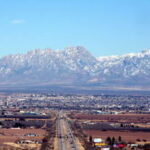Statistics
Saturn is the second largest planet in our solar system, measuring 74,897 miles in diameter. It is, on average, 888,187,982 miles from the sun. Saturn requires 29.5 Earth years to complete one revolution around the sun. It rotates once on its axis every 10 and 2/3 hours, and is tilted on its axis 25.33 degrees. Saturn radiates more heat than it receives from the sun. Its core temperature is 21,140 degrees Fahrenheit. Saturn has a density less than water, at .687g/cubic centimeter, but is 95 times more massive than the Earth.
Composition
Saturn is a gas planet with a hot, molten iron and rocky core. Surrounding the core is a layer of liquid water, ammonia, and methane. A layer of metallic, liquid hydrogen lies between the liquid around the core and the atmosphere. Its atmosphere consists of 96.3% hydrogen, 3.25% helium, and the remaining .45% are trace elements, including acetylene, ammonia, phosphine, ethane, ammonium hydrosulfide, and methane.
Clouds
Saturn’s upper atmosphere is composed of segmented bands of clouds that follow the planetary rotation. The lower layer consists of six miles of water ice, which is -9 degrees Fahrenheit. The next layer, consisting of ammonium hydrosulfide ice is about 31 miles thick and -134 degrees Fahrenheit. The next layer, consisting of ammonia ice is about 50 miles thick and -243 degrees Fahrenheit. The outer layer, consisting of hydrogen and helium is about 124 to 167 miles thick.
Moons
Saturn has sixty-one moons orbiting the planet. The largest moon orbiting Saturn, Titan, measures 3,200 miles in diameter and orbits 759,210 miles from the planet. Titan is named after the giant beings in Greek mythology called Titans, who wished to rule the heavens, but were imprisoned by Zeus. Titan is the only moon in the solar system with a significant atmosphere, composed of nitrogen, argon, and methane. A thick layer of smoggy clouds that obscures the surface of the moon covers Titan.
Three of the sixty-one moons, Atlas, Prometheus and Pandora, scientists believe, help keep the ring system in place. Altas, named after the Greek god that held the heavens on his shoulders, is an irregular moon, measuring 23 x 21 x 16 miles in diameter and orbiting 85,525 miles from Saturn. It shepherds the A-ring around Saturn. Prometheus, named for the Titan that stole from the gods and gave to humanity, measures 90 x 53 x 38 miles in diameter and orbits 86,588 miles from the planet. It shepherds the F-ring around Saturn. Pandora named for the mythological woman who released all the plagues upon humanity, measures 70 x 52 x 38 miles in diameter, and orbits 88,048 miles from Saturn. It also shepherds the F-ring.
Rings
Saturn’s post prominent feature is its system of rings. It has three major bands and four fainter bands of rings, three of which are visible from Earth-based telescopes. They are composed of billions of rocks that orbit the planet, measuring from a few inches to a mile in diameter. The rings are only about 3,280 feet thick, but measure 155,342 miles wide. The particles and rocks themselves consist of ice-covered rocks and frozen water.
Discovery and Namesake
Saturn’s name comes from the Roman god of agriculture, Saturn, who was the offspring of Uranus and Gaia and the father of Jupiter. His Greek counterpart is Kronos, and our seventh day of the week, Saturday, is derived from this mythological being. The Babylonians called this planet Ninurta and the Hindus call it Shani, the judge amongst all planets.
Saturn is the furthest planet visible with the unaided eye, although a telescope is needed to see its rings.
References
“Saturn”; Wikipedia.org
“Saturn”; AbsoluteAstronomy.orgArnett, Bill; “Saturn”; NinePlanets.org; 2005
Spinrad, Hyron; “Saturn”; World Book Online Reference Center; 2004
“Atlas”; AbsoluteAstronomy.com
“Atlas”; NinePlanets.org
“Promethius”; NinePlanets.org
“Pandora”; NinePlanets.org
“Titan”; NinePlanets.org









